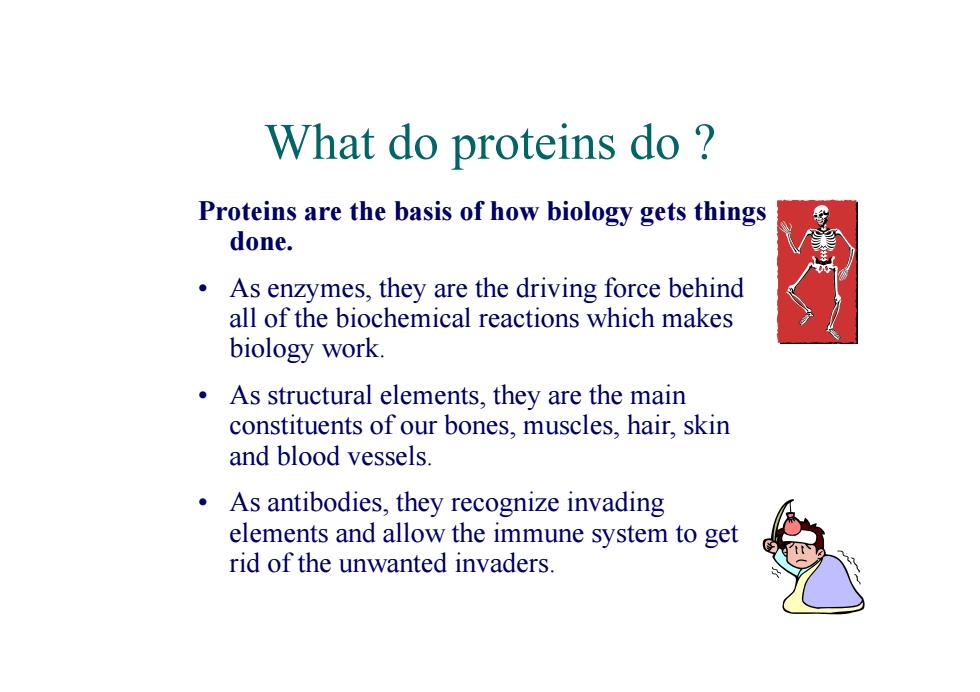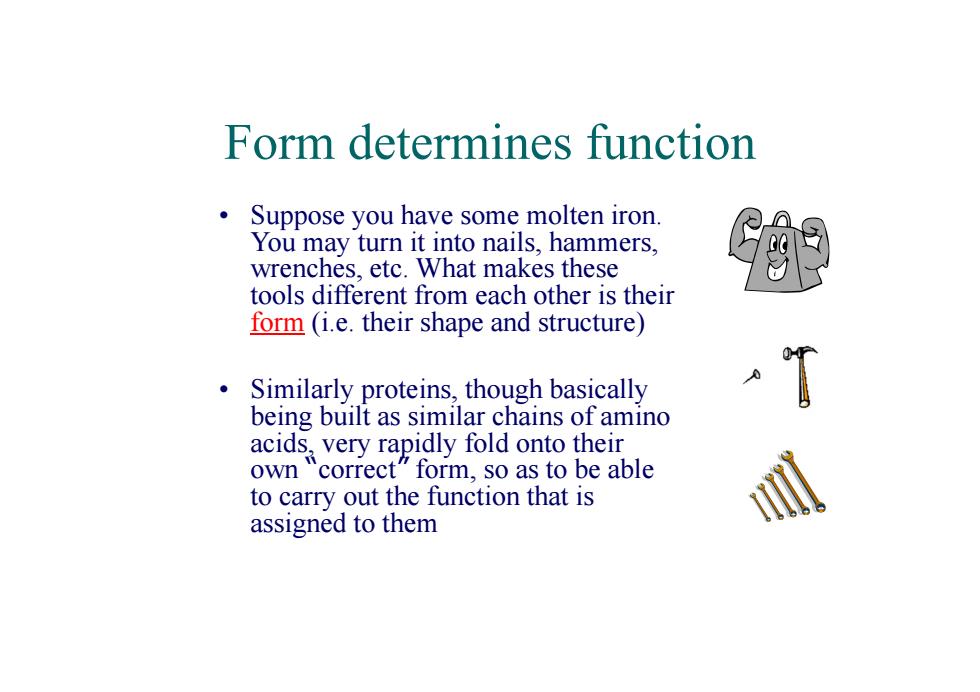
Role of Structural Chemistry in Life Science
Role of Structural Chemistry in Life Science

What do proteins do Proteins are the basis of how biology gets things done. As enzymes,they are the driving force behind all of the biochemical reactions which makes biology work. 。·As structural elements,.they are the main constituents of our bones,muscles,hair,skin and blood vessels. As antibodies,they recognize invading elements and allow the immune system to get rid of the unwanted invaders
What do proteins do ? Proteins are the basis of how biology gets things done. • As enzymes, they are the driving force behind all of the biochemical reactions which makes biology work. • As structural elements, they are the main constituents of our bones, muscles, hair, skin and blood vessels. • As antibodies, they recognize invading elements and allow the immune system to get rid of the unwanted invaders

What are proteins made of Proteins are necklaces of amino acids,i.e.long chain molecules. Primary protein structure is sequence of a chain of amino adds mino Acid 00000ooooo0000ooooooooqoooo H-C-COOH R group Amino Acid
What are proteins made of ? • Proteins are necklaces of amino acids, i.e. long chain molecules

Form determines function ● Suppose you have some molten iron. You may turn it into nails,hammers. wrenches,etc.What makes these tools different from each other is their form (i.e.their shape and structure) Similarly proteins,though basically being built as similar chains of amino acids,very rapidly fold onto their own "correct"form,so as to be able to carry out the function that is assigned to them
Form determines function • Suppose you have some molten iron. You may turn it into nails, hammers, wrenches, etc. What makes these tools different from each other is their form (i.e. their shape and structure) • Similarly proteins, though basically being built as similar chains of amino acids, very rapidly fold onto their own “correct ” form, so as to be able to carry out the function that is assigned to them

How do prions朊蛋白]fold Evidence indicates that the infectious agent in transmissible spongiform encephalopathy is a protein.Stanley Prusiner pioneered the study of these proteins and received the Nobel Prize in The"kiss of death" medicine (1997).He has named them prion proteins(referred to as PrP)or simply prions. A person ingests an abnormally-shaped prion from contaminated food or other contaminated sources. Proteins have primary structures,which is their The abnormally-shaped prion gets absorbed into the sequence of amino acids,and secondary bloodstream and crosses into the nervous system. structures,which is the three dimensional shape that one or more stretches of amino acids take. The abnormal prion touches a normal prion and changes the nommal prion's shape into an abnormal one, The most common shapes are the alpha helix and thereby destroying the normal prion's original function. the beta conformation. Both abnormal prions then contact and change the shapes of other normal prions in the nerve cell. The normal protein is called PrPC(for cellular).Its secondary structure is dominated by alpha helices. The nerve cell tries to get rid of the abnormal prions by The abnormal,disease producing protein called clumping them together in small sacs.Because the PrPSc(for scrapie),has the same primary nerve cells cannot digest the abnormal prions,they accumulate in the sacs structure as the normal protein,but its secondary that grow and engorge the nerve cell,which eventually structure is dominated by beta conformations. dies When the cell dies,the abnormal prions are released to Examples of alpha helices infect other cells. and beta sheets Large,sponge-like holes are left where many cells die
How do prions (朊蛋白) fold ? The “kiss of death” A person ingests an abnormally-shaped prion from contaminated food or other contaminated sources. The abnormally-shaped prion gets absorbed into the bloodstream and crosses into the nervous system. The abnormal prion touches a normal prion and changes the normal prion's shape into an abnormal one, thereby destroying the normal prion's original function. Both abnormal prions then contact and change the shapes of other normal prions in the nerve cell. The nerve cell tries to get rid of the abnormal prions by clumping them together in small sacs. Because the nerve cells cannot digest the abnormal prions, they accumulate in the sacs that grow and engorge the nerve cell, which eventually dies. When the cell dies, the abnormal prions are released to infect other cells. Large, sponge-like holes are left where many cells die. Evidence indicates that the infectious agent in transmissible spongiform encephalopathy is a protein. Stanley Prusiner pioneered the study of these proteins and received the Nobel Prize in medicine (1997). He has named them prion proteins (referred to as PrP) or simply prions. Proteins have primary structures, which is their sequence of amino acids, and secondary structures, which is the three dimensional shape that one or more stretches of amino acids take. The most common shapes are the alpha helix and the beta conformation. The normal protein is called PrPC (for cellular). Its secondary structure is dominated by alpha helices. The abnormal, disease producing protein called PrPSc (for scrapie), has the same primary structure as the normal protein, but its secondary structure is dominated by beta conformations. Examples of alpha helices and beta sheets